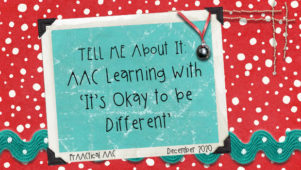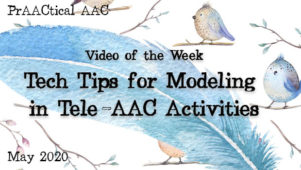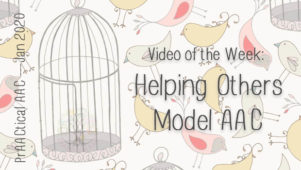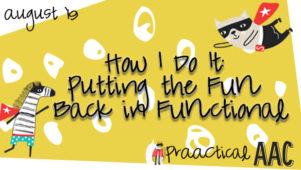How I Do It: Implementing Aided Language Input with Alicia Garcia
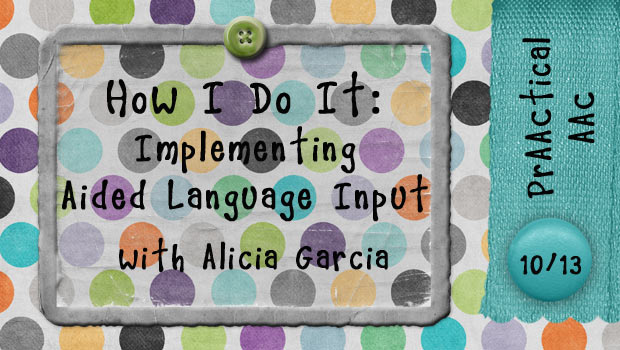
We are so pleased to have reconnected with SLP Alicia Garcia and are even more delighted that she agreed to do a guest post. Alicia is the clinical lead of the AAC Clinic at One Kids Place, a children’s treatment centre in northern Ontario. She has over 20 years of experience in pediatric rehabilitation practice in private and public settings, including clinical practice in AAC clinics and programs in Wisconsin, Florida, and now in Ontario. In this post, Alicia addresses one of our favorite clinical strategies in a very prAACtical way.
Implementing Aided Language Stimulation: 8 Frequent Mistakes and How to Avoid Them
Aided Language seems like a simple concept: Partners should model or demonstrate picture communication when talking to children who are  learning to use picture communication, so that they would learn by example. Yet, when it comes to implementation we see frequent mistakes and misinterpretations. The most commons being:
learning to use picture communication, so that they would learn by example. Yet, when it comes to implementation we see frequent mistakes and misinterpretations. The most commons being:
1. Forgetting that it is about us, communication partners, modeling or demonstrating. Frequently we see partners focusing on merely prompting the child to point or touch the picture symbols to communicate. Remember, it is about what WE do, not about what the child does. Model, model, model.
2. Using Aided Language only to give directives (e.g., “Let’s go to the gym”, “Get ready to eat”, “Pick a colour”). Make sure you provide models of multiple communicative functions and purposes such as:
- Sharing information: “I heard you went to see Spider Man on the weekend”
- Making comments: “That’s awesome!”
- Asking questions: “What is your favourite colour?”
- Greeting: “Hi! I’m happy to see you today!
3. Modeling only our own agenda. Remember, we are using pictures to talk to the child so that he learns how to use them to tell us things that he wants to say, things that matter to him. Pay close attention to the child, and model messages that you know the child would find interesting, useful or meaningful.
4. Missing valuable opportunities to show the child how to communicate with pictures by, either failing to match his non-verbal signals with pictures, or by failing to read the child’s non-verbal signals altogether. Look for what the child communicates with body language and gestures and match those with pictures.
5. Not expanding the child’s message after he uses pictures to tell us something. Remember, if we want to take the child’s expressive skills to the next level, we need to add one or two missing elements when we repeat his messages back to him.
6. Not noticing at what the child is looking when we point to pictures; pay attention to the child’s eyes. If you see his eyes are focusing on a particular picture, “talk” about it! –point about it!
7. Not keeping the communication device at the child’s eye level when composing messages. When using high tech devices to provide aided language, sometimes partners compose the full message or sentence first and then show the final product to the child. The child needs to see every step of the process. Remember we are modeling so that they learn how to imitate it. Keep the device at the child’s eye level at all times so he can see the process clearly.
8. Not following the lead when the child “changes the topic”. If the child starts pointing at a picture not related to what we are talking about / pointing to, then acknowledge the new topic, expand on it and keep the conversation going!
Filed under: PrAACtical Thinking
Tagged With: aided language input, Alicia Garcia, How I Do It
This post was written by Carole Zangari

